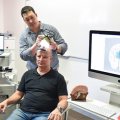Professor Jason Mattingley, Foundation Chair in Cognitive Neuroscience at The University of Queensland, released his findings into ‘brain waves’ at the Australian Neuroscience Society’s (ANS) annual conference last week.
'Brain waves’ are the oscillations produced by the brain, which are thought to contribute to its remarkable capacity to integrate information about the world.
According to Professor Mattingley’s research, brain oscillations can be linked to sleep, navigation, cognition, attention, and to diagnosing a wide range of disorders including autism, schizophrenia and epilepsy.
To understand how the brain filters information during visual attention and perception, Professor Mattingley and his fellow researchers encouraged subjects to perform tasks involving the use of flickering stimuli on a computer display. This included embedding colour-coded visual information to see how well subjects track a specific target colour from a myriad of distracting information.
“Imagine the brain as a stadium full of sports fans. Each spectator is like an individual neuron in the brain. Now imagine the spectators starting a Mexican wave that sweeps through the crowd from one side of the stadium to the other. Our research shows that neurons in the brain act in much the same way. Distinct waves of neural activity, moving at different speeds and in different directions, help coordinate neurons across widely separated areas of the brain,” Professor Mattingley said.
“We can measure these brain waves as people engage in different tasks, such as focusing their attention on just one colour in multi-coloured display. The measurements we take from the brain are a bit like the ripples from a handful of pebbles thrown into a pond.”
“While interesting in their own right, these studies are also relevant to brain dysfunction, as defects in neural responses to flickering visual stimuli have been found in individuals with autism, schizophrenia, and epilepsy, and such oscillations have been found to be significantly altered in aging, depression, and neurodegenerative disorders. Using these tasks may help to both diagnose and understand the basis for differences in brain function in people with these conditions.”
The Australian Neuroscience Society’s (ANS) annual conference brings together researchers in search of a greater understanding of the human nervous system and its functions.
As part of the program around 100 international speakers and delegates shared their insights into the peripheral senses - touch, sight, hearing and smell – perception, cognition, learning and memory, with a particular focus on neurological and neurodegenerative disease.
Media: Helen Weir, Queensland Brain Institute 3346 6404 or h.weir@uq.edu.au
Australian Neuroscience Society
http://www.ans.org.au/
The Australian Neuroscience Society (ANS) is a non-profit organisation of scientists and physicians who study the brain and nervous system and are actively involved in research and teaching. If you have similar interests, we invite you to contact us about joining our society.
Queensland Brain Institute
http://www.qbi.uq.edu.au/
The Queensland Brain Institute (QBI) was established as a research institute of The University of Queensland in 2003. The Institute is now operating out of a new $63 million state-of-the-art facility and houses 33 principal investigators with strong international reputations. QBI is one of the largest neuroscience institutes in the world dedicated to understanding the mechanisms underlying brain function.
Professor Jason Mattingley
Professor Jason Mattingley is the Foundation Chair in Cognitive Neuroscience at The University of Queensland, where he holds a joint appointment between the Queensland Brain Institute and the School of Psychology. Professor Mattingley’s research focus is to understand the brain processes that filter and prioritise sensory inputs, cognitive operations and motor outputs, known collectively as selective attention.
Professor Mattingley’s project will investigate how people use attention to filter sensory information and how the brain controls attention in health and disease. The findings will support new initiatives in a range of fields, from the development of more effective teaching practices, to improved rehabilitation strategies for people with brain injuries.
Professor Mattingley was awarded his PhD from Monash University in 1995. Before moving to The University of Queensland, Professor Mattingley was Director of the Cognitive Neuroscience Laboratory within the School of Behavioural Science at The University of Melbourne. He has also held appointments as a Senior Research Fellow at Monash University and a National Health and Medical Research Council Neil Hamilton Fairley Post-Doctoral Fellow at the University of Cambridge, UK from 1994 to 1997. During his period in Cambridge, Professor Mattingley was a Fellow of King’s College.
Professor Mattingley is a Fellow of the Academy of Social Sciences in Australia, and a member of the Australian Academy of Science’s National Committee for Brain and Mind. He has previously been a member of the NHMRC Neurology and Brain Imaging Grant Review Panel in 2008, and Chair of the NHMRC Psychiatric Brain Imaging Grant Review Panel in 2009.
Professor Mattingley serves as an editorial board member for several international journals, including Brain and Cognition, Cortex, Cognitive Neuroscience, Neurocase, and Neuropsychologia.
.jpg)












